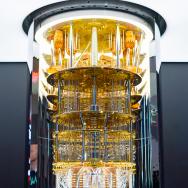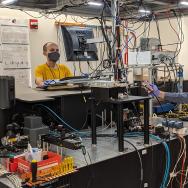When a plant turns a splash of sunlight into a new leaf, that process is more complicated than the latest SpaceX launch, the stock market or brain surgery.
That process, unfolding inside a molecule called the photosynthetic center, involves hundreds of thousands of movements of atoms and electrons. For scientists trying to model it on an ordinary computer, that’s potentially the equivalent of 100 years’ worth of computing hours.
“The underlying mathematics increases in complexity exponentially,” said Prof. David Mazziotti, a theoretical chemist at the University of Chicago. “Trying to pack all that information into a classical computer will run you out of room very quickly.”
Mazziotti is part of a team of scientists working to find ways to use an entirely different tool to run these kinds of simulations: a quantum computer. Led by Prof. Sabre Kais of Purdue University, the team just received a second round of funding from the U.S. Department of Energy for $3 million over three years as part of the department’s program supporting quantum information science research.
In addition to insights that could lead the way to new chemical discoveries, the team hopes to lay the groundwork for quantum computing as a whole. “There’s something fundamental about challenges in quantum chemistry space; if we can solve some of these problems, that’s often felt to be a landmark area that would have a potentially revolutionary impact on the way computing is done in the future,” said Kais.
‘A brave new world’
Kais and Mazziotti—along with Prineha Narang of Harvard University, John Anderson of UChicago, and Libai Huang and Yong Chen of Purdue University—are scientists from different specialties with a shared goal: to be able to understand and predict the workings of molecules. This knowledge is crucial for coming up with new molecules to serve as the basis for new medicines, electronics, and sustainable energy technologies, like solar panels or greener manufacturing processes.
However, the underpinning of many types of molecules is incredibly complex once you get down to the level of atoms and electrons. “A lot of the materials and molecules that are most interesting for 21st century breakthroughs fall into a category called strongly correlated, and that’s where it gets what you might call ‘exciting’ to try to model them,” Mazziotti said.
Even though classical supercomputers are the most powerful computers we’ve ever made, what they do is sequential and logical: solve problem A, use the solution to solve problem B, and so on. Some molecules are simply too complex to be modeled this way.
A quantum computer, meanwhile, can hold all possibilities at the same time. That helps because nature itself runs on quantum mechanics. A quantum computer running a molecule simulation plays by the same rules, speaks the same native language.
“If you run the same problem on a quantum computer, you are actually creating an experiment that mimics the molecule, without ever really doing the underlying math,” Mazziotti said. “Nature knows how to deal with the wave functions in an efficient manner.”
But quantum computers are only now just starting to come online, and scientists don’t have the library of algorithms and understanding of inputting problems that they do for classical computers. Moreover, quantum computers are such an entirely different beast that they have had to start virtually from scratch. “It’s a brave new world out there,” said Anderson.
In their collaboration, the scientists often pass a problem back and forth. For example, Anderson—who is an experimental chemist working in a lab—created a new formulation that he thought might be of interest for electronics. He sent the formulas over to the theoretical chemists, who made a quantum model of the system and found that, at very low temperatures, the system would start to generate unpaired electrons.
“I would never have expected that, but it’s turned out to be very interesting because those unpaired electrons have cool properties, and that’s opened a whole new line of inquiry for us,” said Anderson. For example, it might turn out to be a completely new way to make a qubit, the basis of a quantum computer.
In another collaboration, Narang, Kais and Mazziotti were able to create a model of a photosynthetic center in a plant—one of the more complex systems ever studied on a quantum computer, they said.
“It’s really unusual to collaborate with this many of us who specialize in theoretical science, and it’s been a very enriching—and very scientifically productive—experience,” said Narang. “Each of us has complementary strengths: mathematical physics, materials chemistry, physical chemistry.”
In the first three years of this collaboration, they’ve already seen progress: “When we started, everything was very proof-of-concept, but we’re already at a crossover point where we can do meaningful calculations on quantum computers,” said Kais. “I hope at the end of the next three years, we’ll be running problems that you can’t run at all on a classical computer.”
Funding: U.S. Department of Energy.

